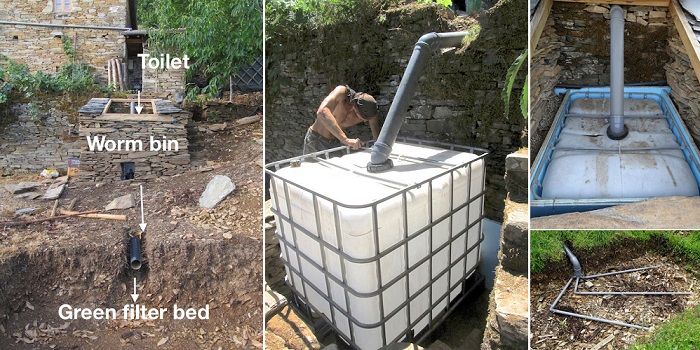Worms evolved to turn plant and animals wastes into soil. After more than 600 million years, they’re perfectly adapted to the task. Aristotle is quoted as saying “Worms are the intestines of the Earth” and it’s not a bad analogy for what they do. Earthworms’ bodies works as ‘biofilters’. They ingest and degrade organic wastes, converting them into nutrient-dense and microbially-rich soil. Their burrows aerate the soil. They lock up heavy metals and organic pollutants within their bodies. They’re able to increase the hydraulic conductivity and natural aeration of soil not just through the physical action of burrowing, but by granulating the clay particles which pass through their bodies.
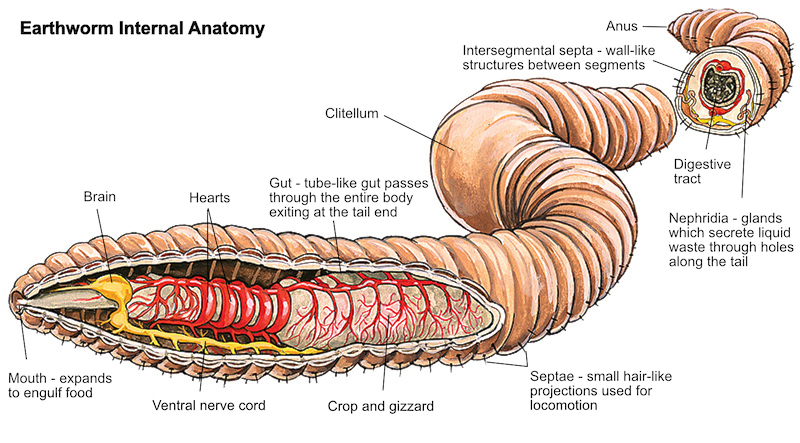
Earthworms survive within a temperature range of 5-29°C. Their optimum temperature range is 20–25°C. Moisture levels of 60–75% are ideal, though they can also tolerate extensive water loss by dehydration. Cold is not as big an issue for them as heat – while their activity slows down a lot in winter, excessive heat can kill them instantly.
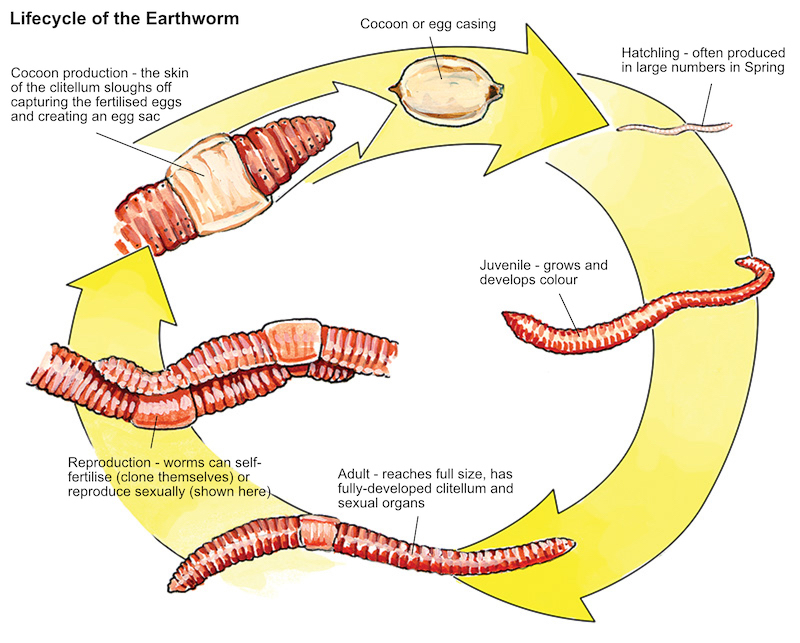
Vermicomposting ecosystems establish and self-regulate very easily, with worm numbers rapidly adapting to availability of food. Earthworms are bisexual and can double their number at least every 60–70 days. Given a good food supply and optimal moisture and temperature conditions, earthworms can multiply by 28, ie. 256 worms every 6 months from a single individual.
The worms also stimulate and accelerate microbial activity in the system by increasing the population of soilmicroorganisms and improving aeration through their burrowing actions. The number of bacteria andactinomycetes contained in ingested material increase up to 1,000 times while passing through earthworm guts. A population of worms numbering about 15,000 will in turn foster a microbial population of billions of millions.
The inspiration for this system design came from Anna Edey, who first constructed a vermicomposting flush toilet in 1995 after decades of experimentation with compost toilets and biofilters.
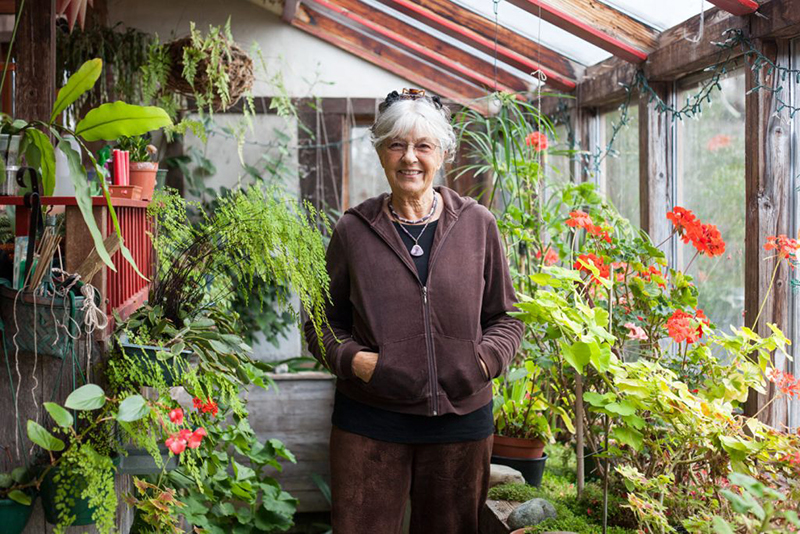
Here, in her own words, is the story …
“Over the years I came to realize that very few people will adopt compostoilets any time soon, no matter how convenient, economical and clean they can be. This realization made me quite pessimistic about the potential for stopping the vast amounts of water pollution currently caused by standard septic systems. So I decided to design a method of combining flush toilets with composting. I am happy to report that I have discovered ways to keep the flush toilet AND to keep drinking water and aquatic ecosystems clean.
“In September 1995, with capable carpenter and plumber, the upstairs compostoilet in my home was removed, and a regular 1.6-gallon flush toilet was installed. The toilet drainpipe empties into an enclosed Compostfilter, a box, 3 feet tall and 4 feet wide, built of wood against the outside wall of the house. The top and the front of the box can open for servicing and inspection. It is lined with plastic to prevent rotting of the wood and the house shingles, and it is insulated with 2-inch rigid foamboard to prevent freezing.
“The Solviva flushtoilet composting system has been transforming human waste and toiletpaper into marvellous compost, healthy plants and clean effluent, since 1995.
“The box is watertight with a drain on the bottom and is divided into two connected compartments. Each compartment is half-filled with Biocarbon mix, consisting of the right type and proportions of partially composted leaves and wood chips. I also installed 3,000 earthworms which I ordered by mail from a worm farm in Georgia, for $19.
“I call this box the Brownfilter. The toilet waste pipe has an elbow at the end that empties into the box. This elbow can be flipped to empty into one or the other of the two compartments. The solids, including the toilet paper, are retained in the compost box, while the liquid quickly seeps through the Biocarbon mix, exits through the drain and into a sloped pipe that leads to a series of ground-level Greenfilters.
“I started flushing into the first compartment as soon as the installation was complete, September 20, 1995. Throughout the first cold winter, even through subzero conditions, the temperatures in the box stayed above 55 degrees F, without any heating source other than the low-temperature (mesophilic) composting process itself. My plan was to flip the toilet waste pipe over to the second compartment when the first one was filled. However, to my utter surprise, it never did fill up, because the process of decomposition has reduced the volume faster than it has increased by the additions of the daily flushings. Seven family members were at my home for a week over that first Christmas, all using this toilet because I wanted to provide a real stress test. The system continued composting and draining reliably.
“After my family left, I flipped the elbow of the toilet waste pipe to drain into the second compartment, in order to get an accurate reading of how long it would take for the solids to fully decompose. To my amazement, I found that within one week there was nothing recognizable left in the first compartment, nothing but rich black earthworm castings and healthy earthworms, which by this time had multiplied to hundreds of thousands of all sizes. When warmer weather returned I found that full decomposition was achieved in less than four days.
“The truly astonishing fact is that the more I put into the box, the less there is in the box. As I write this, in October 1997, 25 months have passed since the installation, with usage ranging from one to seven people. This box has by now received approximately 2,500 flushes, 140 rolls of toilet paper, and 35 cubic feet of leaves and woodchips (the original 12 cubic feet plus periodic additions). The action of the earthworms and other bioorganisms has reduced it all to about 9 cubic feet of magnificent earthworm castings. Even with all my previous experience I never would have expected this could be possible.
“When in its normal closed state, this compost chamber is absolutely odor-free. When you open it, it has a slight fragrance of a well-kept stable. It has never generated any flies, and no earthworms have ever ventured outside, probably because this box is clearly Earthworm Heaven.
“The liquid seeps quickly through this Brownfilter and runs via drain and sloped pipe to a series of Greenfilters. The first is a shallow growing bed filled with the same Biocarbon mix plus sandy topsoil and healthy plants, lined with a waterproof membrane, with a drainpipe that leads downhill to a second Greenfilter, same as the first. From there the liquid drains into a 20-gallon pump chamber equipped with a float switch-controlled sump pump that periodically pumps 15 gallons of effluent into a perforated pipe installed in the third Greenfilter. This is a flower bed, and the pipe is installed in a layer of wood chips 6 inches below the surface. From there the water perks through the subsoil, where any remaining pathogens are destroyed.
“Thus, all the wastes flushed down the toilet are transformed into excellent earthworm casting compost and irrigation water that benefit the landscaping. The nitrogen is absorbed by the Biocarbon filter materials and the plants and does not leach down to contaminate the groundwater.
“I have also conducted other experiments with different versions of my Biocarbon filter, one for treating effluent from a standard septic tank, the other for treating septage and sludge pumped from numerous different septic tanks, including restaurants, businesses and homes. In the case of the septic tank effluent, lab tests showed a 90 percent reduction of the total Kjeldahl nitrogen, from 86 ppm to 8.1 ppm, and a 96 percent reduction of the ammonia-nitrogen, from 77 ppm down to 2.5 ppm. In the case of the Biocarbon septage treatment filter, total nitrogen was reduced 88.2 percent, from 152.34 ppm down to 17.81, while BOD was reduced from 607 ppm to 59 ppm, and COD from 640 ppm to 85 ppm. In both cases the flow-through took less than 10 minutes, and the foul odor was totally removed.
“These results are nothing short of astonishing, to sanitation professionals and lay people alike. The Solviva Biocarbon filter systems demonstrate that we can manage our wastewater in ways that cause 90 percent less pollution than systems currently required by the state, and, in many cases, at far less cost.”
How Vermicomposting Toilets Work…
The solid wastes from the toilet drop into the centre of the tank and fall on the surface of the organic material where they’re consumed by the worms. The flush water passes through the organic material which, after the ecosystem has had a chance to develop, is colonised by billions of bacteria as well as the worms. Bacteria remove nitrates from the waste water and use them to break down the carbon locked up in the organic material. Worms degrade thewastewater organics by enzymatic action (enzymes work as biological catalysts bringing pace and rapidity in biochemical reactions).
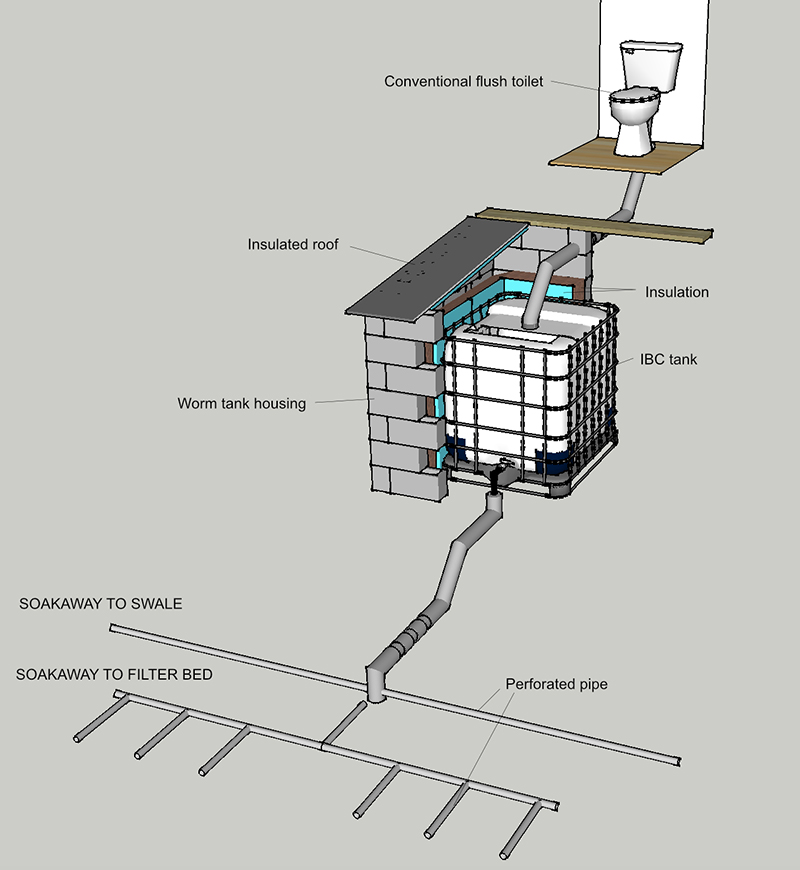
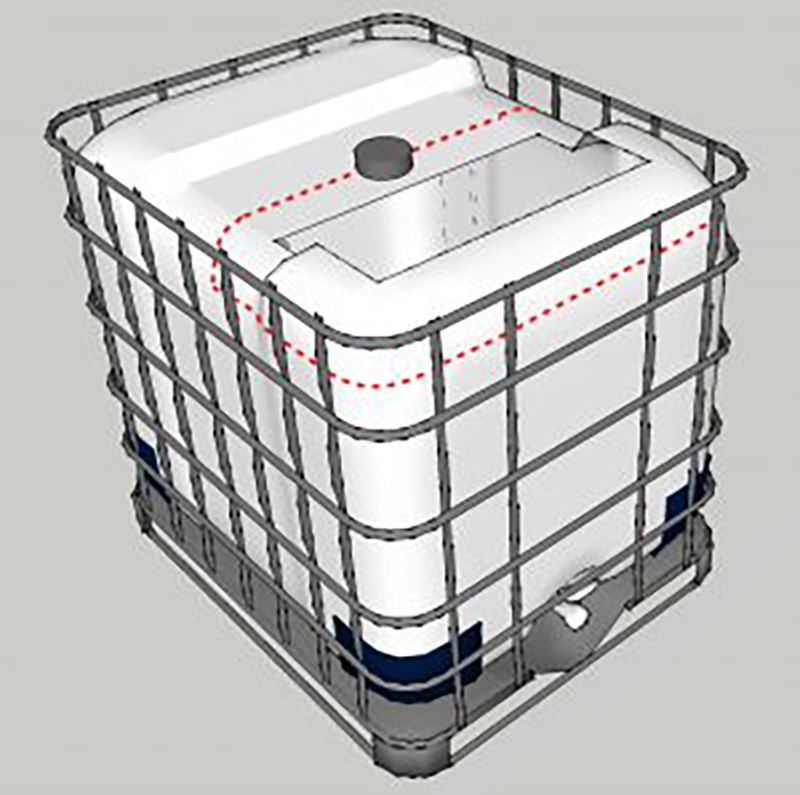
The reduction in the 5-day Biological/Biochemical Oxygen Demand(BOD5), one of the principle measures used in the assessment of successful sewage treatment, is typically over 90% in as short a throughput time as 10 minutes. In 1-2 hours, 98-100% can be removed. Chemical Oxygen Demand (COD) is reduced by 80–90%, total dissolved solids (TDS) by 90–92%, and the total suspended solids (TSS) by 90–95%.
There is no sludge and no clogging. All wastes are consumed within the tank, including toilet paper.
The vermifiltered water leaving the worm tank can be cleaned further in any of, or a series of, greenfilter beds, on-contour percolation trenches (swales) or mulch pits, sized according to the volume of water passing through the tank. If grey water is being processed through the tank as well as black water, this part of the system needs to be several times larger than it would be for black water alone.
Since the water has already been cleaned in its passage through the worm tank, pipe length calculations and soil depth requirements based on hydraulic loading rates for domestic septic tank percolation trenches and leach fields are far in excess of what’s required.
Greenfilter beds, percolation trenches and mulch pits fed by a vermicomposting system are filled to a depth of 0.5m with the same organic material as is used in the worm tank. This encourages the development of the same ecosystem within a loose-textured, well-aerated matrix, so similar rapid percolation rates can be expected within the organic layer of the greenfilter as are seen in the worm tank.
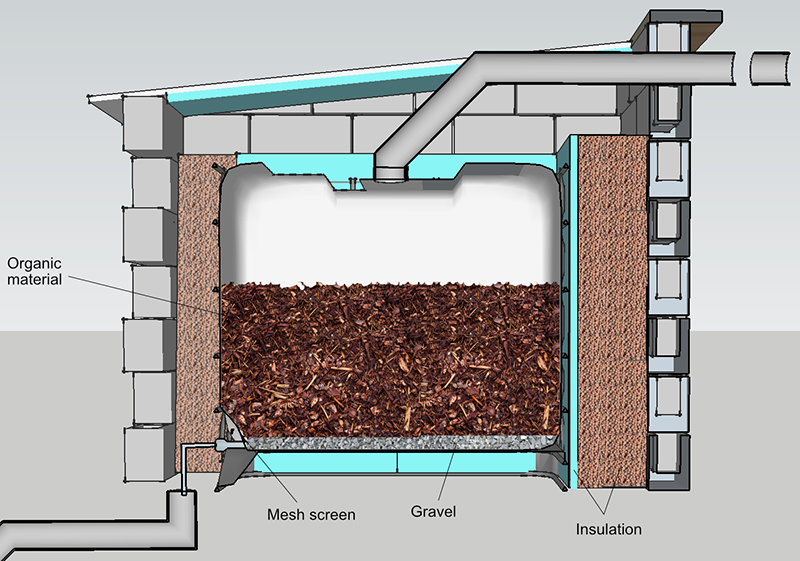
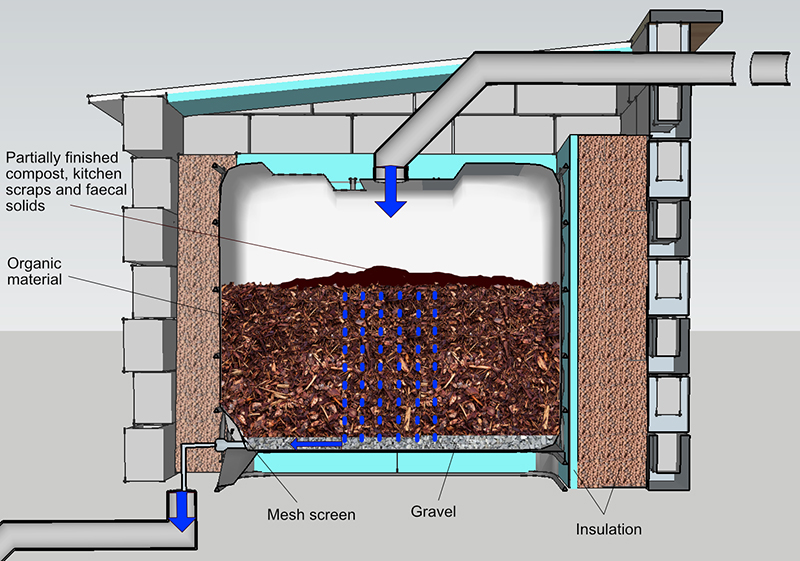
Worm eggs will pass out of the tank in thevermifiltered water to colonise thegreenfilter areas. While permitting rapid percolation, the organic material will also act as a sponge to hold water for uptake by plants and will serve to improve the texture, fertility and water retention capacity of the surrounding soil as well as forming the principal substrate for a massive increase in the soil biota present.
This results in cleaner water with fertility, moisture and fungal communication pathways for the vegetation. It will also improve the percolation rates through the surrounding soil as it too is colonised by worms, improving texture and aeration. Earthworms are able to increase the hydraulic conductivity and natural aeration of soil not just through the physical action of burrowing, but by granulating the clay particles which pass through their bodies.
This is a whole different equation to working with an essentially inorganic filtration concept. As with the worm tank, it’s a self-regulating living system.
The minimum recommended soil depth for a conventional septic system to operate effectively is 1 to 1.5m. This is not the case with a vermicomposting system. The ‘greenfilter’ areas need a minimum soil depth of only 0.5m.
Hydraulic loading rates for conventional septic systems are generally based on infiltration rates though clogged soil surfaces for domestic septic tank effluent. Current practice has been to simply apply these rates, 0.07 to 0.42 litres per day per m2 or 0.20 to 1.2 gallons per day/ft2, to the infiltrative surface bottom area with the site-specific rate based upon the soil textural properties. Often soil textural properties are assessed with reference only to the mineralogical properties of the soil itself, not the amount of organic material and soil biota present. Yet it’s the latter which primarily determine how well the waste water is cleaned and purified.
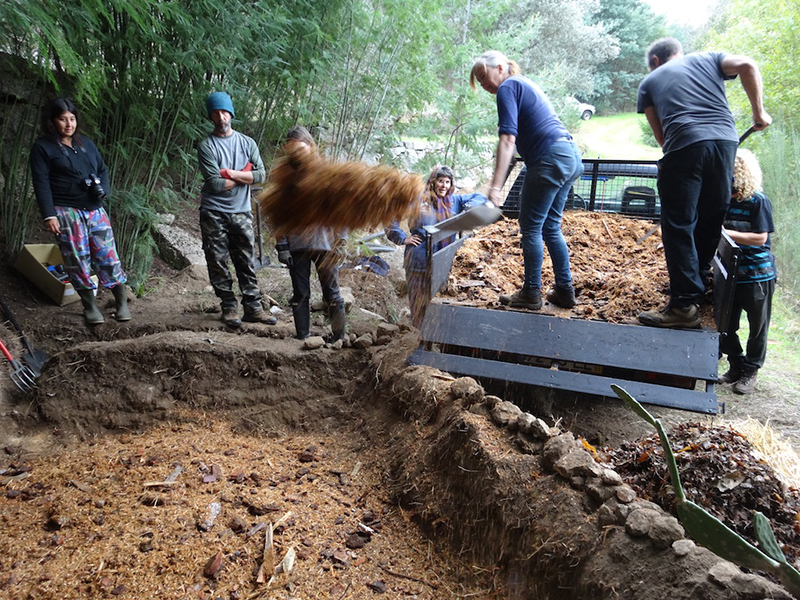
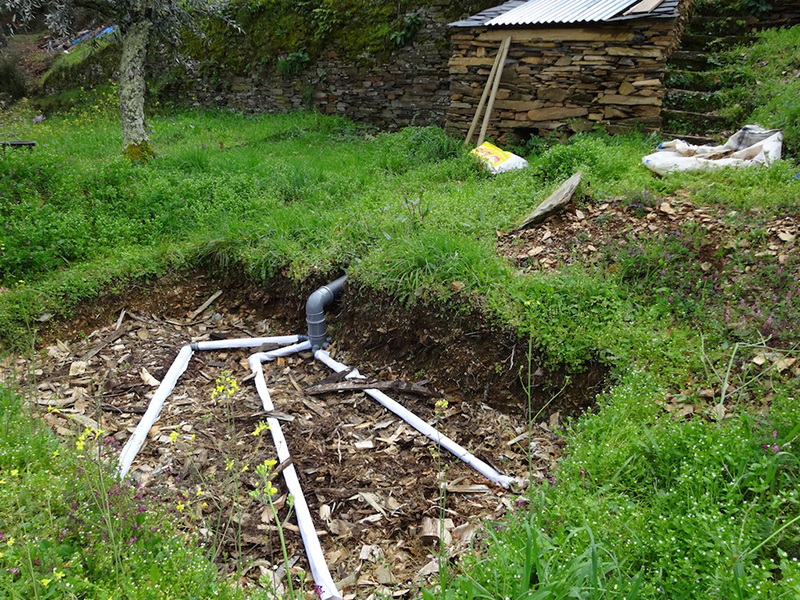
Since every individual installation will be unique to its particular context, as a guide, the area of greenfilter required can be calculated by reference to soil percolation tests for grey water discharge. Since these are also calculated without taking into account the level of soil biota present, it’s likely to provide a comfortable margin of error.
Run pipework from the worm tank to a distribution box in the greenfilter area(s) in the same diameter as the supply. From the distribution box, run smaller diameter perforated pipe through the uppermost 20cm of the organic material. Wrap the perforated pipes in geotextile filter fabric or horticultural fleece to prevent blocking by the organic material.
For on-contour percolation trenches or swales, the perforated pipework should also be laid on contour. Mulch pits don’t require perforated pipework. Small diameter waste pipes fed from the distribution box are sufficient. Greenfilter areas serve best to irrigate trees and shrubs, and can include edible species. For more information check out VermicompostingToilets.
You can learn more about setting up a successful worm composting operation here.
If you like this idea, be sure to share it with your friends and inspire someone you know. Anything becomes possible with just a little inspiration…
